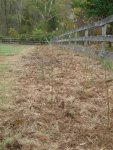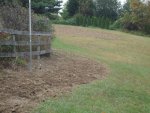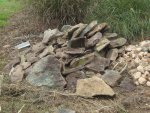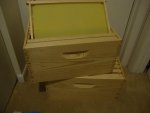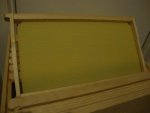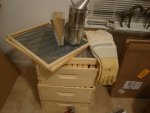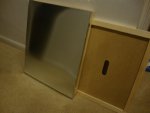- Joined
- Jun 23, 2010
- Messages
- 44,905
- Reaction score
- 29,890
- Location
- Frederick, Maryland
- Showcase(s):
- 1
- Hardiness Zone
- 6b
- Country

We have decided to take on another hobby! It relates to ponds, plants, veg gardens, life in general.
I have planted our yard with bee, bird, butterfly, insect friendly plants. Never spray any chemical. With the plight of the honey bee, my honey encouraged me to try bee hives.
So we are going to set up two bee hives next spring. Now the learning curve starts!
What I have learned so far:
...Buying hives is expensive (find someone getting out of the work) We bought new ones.........ouch
...There are no commercial bee keepers in Maryland, our nectar flow season is too short, we get nectar from april to mid july. The flow starts with the first dandelion that opens.
...The first summer of having bees, you get no honey to harvest. You leave it for the bees to be able to make it through the next winter. That first pound of honey will be expensive!
...Even with all the flowers we have planted, bee friendly, the flowers can be native bee friendly, but not honey bee friendly. They all have different lengths of proboscis, some long some short. The flowers need to match the proboscis of the honey bee.
...A worker bee will produce 1/12 teaspoon of honey in its life, 20-30 days.
...They need water to create the honey............that is easy we have a ton of water.
...The hive stays 94-96 degrees summer and winter.
...HONEY IS VERY VERY VERY HEALTHY FOR YOU
We bought honey bee friendly wildflower seeds. Will be seeding this fall (if we are predicted to have a cold winter) in the spring if it stays warm. Don't want the seeds to sprout and die from a warm winter. With the honey bee friendly flowers, which deer love, we are now putting up electric fence to protect the wildflower fields. Also planting an area for the deer to eat. Mint produces great nectar, so taking some of our water mint and planting it out in the back field, let it take over. Clover is another wonderful nectar producer, throwing out clover seeds in the back field.
If the bear is still around we need to put electric fencing around the hives to protect them.
Just spent the last 3 hours nailing together supers and brood chambers (3 boxes with 10 frames each) have 9 more to go.
At least have until spring to get all together, that is when we get our bees. You can buy a bee package, 3 or 4 lbs of bees and a queen or a nuc of bees 5 frames of eggs, larvae, workers and a queen. A nuc gives you a head start on the bee hive.
You also have to decide what kind of bee to buy, Italian, Russian, etc. We are getting Italian, bigger cluster during the winter, better chance of surviving our short nectar flow and winter.
Also in this mix is where to put the hives. Sunny, out of of the prevailing winds, on your higher land, air flow and not as damp as low land.
Then you need to learn about parasites, diseases, preventing swarming, smoking, harvesting ............ keeps the brain young all this learning.
I have planted our yard with bee, bird, butterfly, insect friendly plants. Never spray any chemical. With the plight of the honey bee, my honey encouraged me to try bee hives.
So we are going to set up two bee hives next spring. Now the learning curve starts!
What I have learned so far:
...Buying hives is expensive (find someone getting out of the work) We bought new ones.........ouch
...There are no commercial bee keepers in Maryland, our nectar flow season is too short, we get nectar from april to mid july. The flow starts with the first dandelion that opens.
...The first summer of having bees, you get no honey to harvest. You leave it for the bees to be able to make it through the next winter. That first pound of honey will be expensive!
...Even with all the flowers we have planted, bee friendly, the flowers can be native bee friendly, but not honey bee friendly. They all have different lengths of proboscis, some long some short. The flowers need to match the proboscis of the honey bee.
...A worker bee will produce 1/12 teaspoon of honey in its life, 20-30 days.
...They need water to create the honey............that is easy we have a ton of water.
...The hive stays 94-96 degrees summer and winter.
...HONEY IS VERY VERY VERY HEALTHY FOR YOU
We bought honey bee friendly wildflower seeds. Will be seeding this fall (if we are predicted to have a cold winter) in the spring if it stays warm. Don't want the seeds to sprout and die from a warm winter. With the honey bee friendly flowers, which deer love, we are now putting up electric fence to protect the wildflower fields. Also planting an area for the deer to eat. Mint produces great nectar, so taking some of our water mint and planting it out in the back field, let it take over. Clover is another wonderful nectar producer, throwing out clover seeds in the back field.
If the bear is still around we need to put electric fencing around the hives to protect them.
Just spent the last 3 hours nailing together supers and brood chambers (3 boxes with 10 frames each) have 9 more to go.
At least have until spring to get all together, that is when we get our bees. You can buy a bee package, 3 or 4 lbs of bees and a queen or a nuc of bees 5 frames of eggs, larvae, workers and a queen. A nuc gives you a head start on the bee hive.
You also have to decide what kind of bee to buy, Italian, Russian, etc. We are getting Italian, bigger cluster during the winter, better chance of surviving our short nectar flow and winter.
Also in this mix is where to put the hives. Sunny, out of of the prevailing winds, on your higher land, air flow and not as damp as low land.
Then you need to learn about parasites, diseases, preventing swarming, smoking, harvesting ............ keeps the brain young all this learning.



